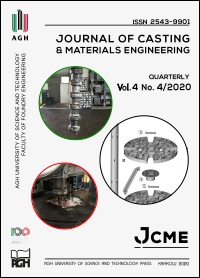An Evaluation of the Effect of Ultrasonic Degassing on Components Produced by High Pressure Die Casting
DOI:
https://doi.org/10.7494/jcme.2020.4.4.58Abstract
Ultrasonic treatment is known to be efficient for aluminium melt degassing with the additional benefits of being both economical and environment friendly. This paper describes the effect of ultrasonic degassing on the preparation of an AlSi9Cu3(Fe) alloy for High Pressure Die Casting (HPDC). The degassing efficiency was assessed in terms of the indirect evaluation of the melt, by means of the reduced pressure test and the porosity evaluation of the cast parts. Additionally, the corresponding hydrogen content was estimated with an experimental equation reported in the literature. Ultrasonic degassing shows greater efficiency in terms of hydrogen removal from the melt than conventional N2 + Ar lance bubbling. Components produced by HPDC without degassing, with ultrasonic degassing and with lance degassing, were analysed by computed tomography and by metallography. The results show that the components produced by HPDC after ultrasonic degassing have a similar porosity level to components degassed with conventional lance bubbling, both showing an important improvement over components produced without degassing treatment. Hardness values were similar for all different treatment conditions and well over the minimum value established for the alloy by the corresponding standard.
Downloads
References
Campbell J. (2003). Castings, 2nd Ed. Oxford: Butterworth-Heinemann.
Eskin G. & Eskin D. (2014). Ultrasonic Treatment of Light Alloy Melts, 2nd Ed. Boca Raton: CRC Press.
Eskin D., Alba-Baena N., Pabel T. & da Silva M. (2015). Ultrasonic degassing of aluminium alloys: basic studies and practical implementation. Materials Science and Technolgy, 31(1), 79–84. Doi: https://doi.org/10.1179/1743284714Y.0000000587.
Esmarch W., Rommel T. & Benther K. (1940). Werkstoff-Sonderheft. Berlin: W.V. Siemens Werke, 78–87.
Bradfield G. (1950). Summarized Proceedings of Symposium on Applications of Ultrasonics. Proceedings of the Physical Society B, 305–321. Doi: https://doi.org/10.1088/0370-1301/63/5/301.
Eskin G. (1965). Ul'trazvukovaya obrabotka rasplavlennogo alyuminiya [Ultrasonic Treatment of Molten Aluminum]. Moskva: Metallurgija. [Эскин Г. (1965). Ультразвуковая обработка расплавленного алюминия. Москва: Металлургия].
Xu H., Meek T.T. & Han Q. (2008). Effect of ultrasonic vibration on degassing of aluminium alloy. Materials Science and Engineering A, 473(1–2), 96–104. Doi: https://doi.org/10.1016/j.msea.2007.04.040.
Puga H., Barbosa J., Tuan N.Q. & Silva G. (2004). Effect of ultrasonic degassing on performance of Al-based components. Transactions of Nonferrous Metals Society of China, 24 (11), 3459–3464. Doi: https://doi.org/10.1016/S1003-6326(14)63489-0.
Galarraga H., Garcia de Cortazar M., Arregi E., Iparraguirre J.A. & Oncala J.L. (2018). Improved ultrasonic degassing of AlSi10Mg alloy and its performance evaluation with reducer pressure test (RPT) method. The 73rd World Foundry Congress: September 23–27. Krakow. World Foundry Association Ltd., 337–338.
da Silva M., Rebolledo L., Pabel T., Petkov T., Planta X., Tort J. & Eskin D. (2015). Evaluation of effect of ultrasonic degassing on components produced by low pressure die casting. International Journal of Cast Metals Research, 28 (4), 193–200. Doi: https://doi.org/10.1179/1743133614Y.0000000141.
Ignaszak Z. & Hajkowski J. (2015). Contribution to the Identification of Porosity Type in AlSiCu High-Pressure-Die-Castings by Experimental and Virtual Way. Archives of Foundry Engineering, 15(1), 143–151.
Niklas A., Orden S., Bakedano A., da Silva M., Nogués E. & Fernández-Calvo A.I. (2016). Effect of solution heat treatment on gas porosity and mechanical properties in a die cast step test part manufactured with a new AlSi10MnMg(Fe) secondary alloy. Materials Science and Engineering A, 667(14), 376–382. Doi: https://doi.org/10.1016/j.msea.2016.05.024.
Mondolfo L.F. (1976). Aluminum Alloys. Structure & Properties. London: Butterworth & Co., 759–805.
Powell M., Manchiraju K. & Han Q. (2016). Ultrasonic grain refining of continuous cast aluminium: microstructure and properties. TMS Conference Light Metals: February 14–18. Nashvile, 737–740. Doi: https://doi.org/10.1007/978-3-319-48251-4_124.
Haghayeghi R., Ezzatneshan E. & Bahai H. (2015). Grain refinement of AA5754 aluminium alloy by ultrasonic cavitation: experimental study and numerical simulation. Metals and Materials International, 21, 109–117. Doi: https://doi.org/10.1007/s12540-014-6015-5.
Ghassemali E., Riestra M., Bogdanoff T., Bharath S. Kumar & Seifaddine S. (2017). Hall–Petch equation in a hypoetutectic Al-Si cast alloy: grain size vs. secondary dendrite arm spacing. Procedia Engineering, 207, 19–24. Doi: https://doi.org/10.1016/j.proeng.2017.10.731.
Basavakumar K.G., Mukunda P.G., Chakraborty M. (2008). Influence of grain refinement and modification on microstructure and mechanical properties of Al-7Si and Al-7Si-2.5Cu cast alloys. Materials Characterization, 283–289. Doi: https://doi.org/10.1016/j.matchar.2007.01.011.
Tiryakioglu M., Campbell J., Staley J. (2000). Hardness-Strength Relationships in Cast Al-Si-Mg Alloys. Materials Science Forum, 331–337, 295–300. Doi: https://doi.org/10.4028/www.scientific.net/MSF.331-337.295.
Piatkowski J., Przeliorz R., Gontarczyk A. (2016). The study of phase transformations of AlSi9Cu3 alloy by DSC method, Archives of Foundry Engineering, 16 (4), 109–112. Doi: https://doi.org/10.1515/afe-2016-0093.
Downloads
Published
Issue
Section
How to Cite
Accepted 2020-12-23
Published 2021-01-18


